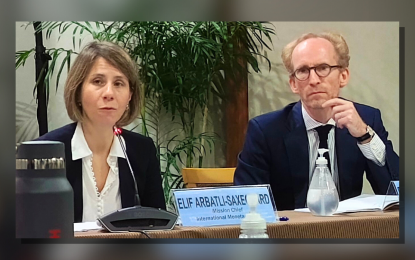
ECONOMIC OUTLOOK. International Monetary Fund Resident Representative to the Philippines Ragnar Gudmundsson (right) and IMF mission chief Elif Arbatli Saxegaard hold a press briefing at the Bangko Sentral ng Pilipinas office in Manila on Wednesday (Oct. 2, 2024). The IMF officials discussed the country's economic growth outlook. (Photo by Leah Gonzales)
MANILA – The Philippine economy successfully navigated multiple external headwinds in recent years and is expected to grow by over 6 percent next year, an International Monetary Fund (IMF) official said.
In a briefing at the Bangko Sentral ng Pilipinas office in Manila on Wednesday, IMF Mission Chief Eli Arbatli Saxegaard said the Philippines remained among the best performing economies in the region.
An IMF team led by Saxegaard held meetings in Manila from Sept. 18 to Oct. 2 to conduct discussions on the Philippine economy for the 2024 Article IV Consultation.
Saxegaard said the Philippine economy is projected to grow by 5.8 percent this year and will further accelerate to 6.1 percent in 2025.
"This pick-up in growth will be supported by more accommodative financial conditions and higher investment," she said.
The latest projection, however, was lower than the 6 percent and 6.2 percent previous forecast for 2024 and 2025.
"The downward revision from our July forecast reflects our view that private consumption is going to grow slightly with less momentum. So I would like to highlight that the downgrade is very small, 0.2, and reflects the fact that the first half (of the year) private consumption growth was lower than what we had anticipated. And this might be in part driven by the high food prices," Saxegaard said.
Despite the revision, Saxegaard said the Philippines continues to be one of the highest growing economies in the region.
"I would also like to highlight that the growth forecast for the Philippines remains one of the highest in the region. It's 6.1 percent growth for 2025, is a very respectable growth rate… So it's a very small adjustment reflecting the outturns the first half," she said.
Downside risks to the country's growth outlook include a slowdown in major economies that could disrupt trade and financial flows; commodity price volatility and supply shocks; and an escalation of geopolitical tensions or regional conflicts.
Easing of global financial conditions, or faster than anticipated private investment linked to public-private-partnerships and larger foreign direct investment inflows, on the other hand, could stimulate higher growth.
The IMF believes that the Philippine economy holds significant potential with its abundant natural resources, untapped blue economy, and a sizable demographic dividend.
Saxegaard, however, said that unlocking the medium-term growth potential will depend on structural reforms and strengthened social protection programs.
She said priority areas include upgrading infrastructure, making significant investments in healthcare and education, addressing land fragmentation and low productivity in agricultural sector, and enhancing governance.
Inflation, meanwhile, is projected to settle within the government's target for both 2024 and 2025.
"We believe that the decisive monetary tightening and other measures have helped mitigate inflationary pressures in the Philippines, recent tariff cuts on imported rice and other non-monetary measures helped reduce food prices, and should further reduce headline inflation by the year end," Saxegaard said.
"For this year, our expectation is that for inflation to average 3.3 percent, and for next year, 3 percent. That would be supported by lower food and core inflation remaining well within the target."
Saxegaard said that with inflation returning toward target, a continued gradual reduction of the policy rate is appropriate.
IMF Resident Representative to the Philippines Ragnar Gudmundsson, for his part, said there are both upside and downside risks to inflation.
"Inflation could perform even better than anticipated. If, for instance, food prices continue coming down, especially rice prices, there would be a positive development that could support monetary policy easing," he said.
"However, we're also aware that there are upside risks to inflation. You know, the commodity prices like oil prices can fluctuate very rapidly, very widely. These are dependent on developments abroad. And this is why the data dependent approach is very important." (PNA)
